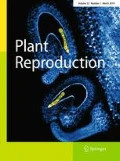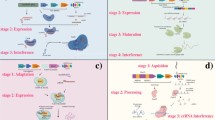Abstract
Many species of Rosaceae, Solanaceae, and Plantaginaceae exhibit S-RNase-based self-incompatibility (SI) in which pistil-part specificity is controlled by S locus-encoded ribonuclease (S-RNase). Although recent findings revealed that S locus-encoded F-box protein, SLF/SFB, determines pollen-part specificity, how these pistil- and pollen-part S locus products interact in vivo and elicit the SI reaction is largely unclear. Furthermore, genetic studies suggested that pollen S function can differ among species. In Solanaceae and the rosaceous subfamily Maloideae (e.g., apple and pear), the coexistence of two different pollen S alleles in a pollen breaks down SI of the pollen, a phenomenon known as competitive interaction. However, competitive interaction seems not to occur in the subfamily Prunoideae (e.g., cherry and almond) of Rosaceae. Furthermore, the effect of the deletion of pollen S seems to vary among taxa. This review focuses on the potential differences in pollen-part function between subfamilies of Rosaceae, Maloideae, and Prunoideae, and discusses implications for the mechanistic divergence of the S-RNase-based SI.
Similar content being viewed by others
References
Cheng J, Han Z, Xu X, Li T (2006) Isolation and identification of the pollen-expressed polymorphic F-box genes linked to the S-locus in apple (Malus × domestica). Sex Plant Reprod 19:175–183
Crane MB, Lewis D (1942) Genetical studies in pears. III. Incompatibility and sterility. J Genet 43:31–44
de Nettancourt D (2001) Incompatibility and incongruity in wild and cultivated plants. Springer, Berlin
Entani T, Iwano M, Shiba H, Che F-S, Isogai A, Takayama S (2003) Comparative analysis of the self-incompatibility (S-) locus region of Prunus mume: identification of a pollen-expressed F-box gene with allelic diversity. Genes Cells 8:203–213
Franklin-Tong VE (2008) Self-incompatibility in flowering plants—evolution, diversity, and mechanisms. Springer, Berlin
Golz JF, Su V, Oh H-Y, Kusaba M, Newbigin E (2001) Genetic analysis of Nicotiana pollen-part mutants is consistent with the presence of an S-ribonuclease inhibitor at the S locus. Proc Natl Acad Sci USA 98:15372–15376
Hauck NR, Ikeda K, Tao R, Iezzoni AF (2006a) The mutated S f-haplotype in sour cherry has an altered S haplotype-specific F-box protein gene. J Hered 97:514–520
Hauck NR, Yamane H, Tao R, Iezzoni AF (2006b) Accumulation of nonfunctional S-haplotypes results in the breakdown of gametophytic self-incompatibility in tetraploid Prunus. Genetics 172:1191–1198
Hua ZH, Kao T (2006) Identification and characterization of components of a putative Petunia S-locus F-box-containing E3 ligase complex involved in S-RNase-based self-incompatibility. Plant Cell 18:2531–2553
Hua Z-H, Fields A, Kao T-h (2008) Biochemical models for S-RNase-based self-incompatibility. Mol Plant 1:575–585
Huang S-X, Wu H-Q, Li Y-R, Wu J, Zhang S-J, Heng W, Zhang S-L (2008) Competitive interaction between two functional S-haplotypes confer self-compatibility on tetraploid Chinese cherry (Prunus pseudocerasus Lindlcv. Nanjing Chuisi). Plant Cell Rep 27:1075–1085
Ikeda K, Ushijima K, Yamane H, Tao R, Hauck NR, Sebolt AM, Iezzoni A (2005) Linkage and physical distances between the S haplotype S-RNase and SFB in sweet cherry. Sex Plant Reprod 17:289–296
Kakui H, Tsuzuki T, Koba T, Sassa H (2007) Polymorphisms of SFBB -γ and its use for S genotyping in Japanese pear (Pyrus pyrifolia). Plant Cell Rep 26:1619–1625
Lai Z, Ma W, Han B, Liang L, Zhang Y, Hong G, Xue Y (2002) An F-box gene linked to the self-incompatibility (S) locus of Antirrhinum is expressed specifically in pollen and tapetum. Plant Mol Biol 50:29–42
Lansari A, Iezzoni A (1990) A preliminary analysis of self-incompatibility in sour cherry. HortSci 25:1636–1638
McClure B (2006) New views of S-RNase-based self-incompatibility. Curr Opin Plant Biol 9:639–646
Newbigin E, Paape T, Kohn JR (2008) RNase-based self-incompatibility: puzzled by Pollen S. Plant Cell 20:2286–2292
Okada K, Tonaka N, Moriya Y, Norioka N, Sawamura Y, Matsumoto T, Nakanishi T, Takasaki-Yasuda T (2008) Deletion of a 236 kb region around S 4-RNase in a stylar-part mutant S sm4 -haplotype of Japanese pear. Plant Mol Biol 66:389–400
Qiao H, Wang H, Zhao L, Zhou J, Lai Z, Zhang Y, Robbins TP, Xue Y (2004) The F-box protein AhSLF-S2 controls the pollen function of S-RNase-based self-incompatibility. Plant Cell 16:2307–2322
Saito T, Sato Y, Sawamura Y, Shoda M, Kotobuki K (2002) Studies on breeding of self-compatibility in Japanese pear. 2. Characteristic of pollen of the S 4sm gene originated from ‘Osanjisseiki’. J Jpn Soc Hort Sci 71(suppl 2):123 (in japanese)
Sassa H, Hirano H, Nishino T, Koba T (1997) Style-specific self-compatible mutation caused by deletion of the S-RNase gene in Japanese pear (Pyrus serotina). Plant J 12:223–227
Sassa H, Kakui H, Miyamoto M, Suzuki Y, Hanada T, Ushijima K, Kusaba M, Hirano H, Koba T (2007) S locus F-box brothers: multiple and pollen-specific F-box genes with S haplotype-specific polymorphisms in apple and pear. Genetics 175:1869–1881
Sato Y, Kurihara A, Abe K, Ogata T, Kajiura I, Kotobuki K, Machida Y (1988) Studies on the mode of inheritance of self-compatibility in Japanese pear. J Jpn Soc Hort Sci 57(suppl 2):76–77 (in japanese)
Sijacic P, Wang X, Skirpan AL, Wang Y, Dowd PE, McCubbin AG, Huang S, Kao TH (2004) Identification of the pollen determinant of S-RNase-mediated self-incompatibility. Nature 429:302–305
Sonneveld T, Tobutt KR, Vaughan SP, Robbins T (2005) Loss of pollen-S function in two self-compatible selections of Prunus avium is associated with deletion/mutation of an S haplotype-specific F-box gene. Plant Cell 17:37–51
Tsukamoto T, Hauck NR, Tao R, Jiang N, Iezzoni AF (2006) Molecular characterization of three non-functional S-haplotypes in sour cherry (Prunus cerasus). Plant Mol Biol 62:325–479
Ushijima K, Sassa H, Dandekar AM, Gradziel TM, Tao R, Hirano H (2003) Structural and transcriptional analysis of the self-incompatibility locus of almond: identification of a pollen-expressed F-box gene with haplotype-specific polymorphism. Plant Cell 15:771–781
Ushijima K, Yamane H, Watari A, Kakehi E, Ikeda K, Hauck NR, Iezzoni A, Tao R (2004) The S haplotype-specific F-box protein gene, SFB, is defective in self-compatible haplotypes of Prunus avium and P. mume. Plant J 39:573–586
Vieira J, Fonseca NA, Vieira CP (2009) RNase-based gametophytic self-incompatibility evolution: questioning the hypothesis of multiple independent recruitments of the S-pollen gene. J Mol Evol 69:32–41
Wheeler D, Newbigin E (2008) Expression of 10 S-class SLF-like genes in Nicotiana alata pollen and its implications for understanding the pollen factor of the S locus. Genetics 177:2171–2180
Xue Y, Zhang Y, Yang Q, Li Q, Cheng Z, Dickinson HG (2009) Genetic features of a pollen-part mutation suggest an inhibitory role for the Antirrhinum pollen self-incompatibility determinant. Plant Mol Biol 70:499–509
Yamane H, Tao R (2009) Molecular basis of self-(in)compatibility and current status of S-genotyping in rosaceous fruit trees. J Jpn Soc Hort Sci 78:137–157
Yamane H, Ikeda K, Ushijima K, Sassa H, Tao R (2003) A pollen-expressed gene for a novel protein with an F-box motif that is very tightly linked to a gene for S-RNase in two species of cherry, Prunus cerasus and P. avium. Plant Cell Physiol 44:764–769
Acknowledgments
We thank Koichiro Ushijima for critical reading of the manuscript. Research in the authors’ laboratory is supported in part by the Grants-in-Aid for Scientific Research (B, 20380003) from the Ministry of Education, Science, Sports and Culture of Japan.
Author information
Authors and Affiliations
Corresponding author
Additional information
Communicated by Scott Russell.
Rights and permissions
About this article
Cite this article
Sassa, H., Kakui, H. & Minamikawa, M. Pollen-expressed F-box gene family and mechanism of S-RNase-based gametophytic self-incompatibility (GSI) in Rosaceae. Sex Plant Reprod 23, 39–43 (2010). https://doi.org/10.1007/s00497-009-0111-6
Received:
Accepted:
Published:
Issue Date:
DOI: https://doi.org/10.1007/s00497-009-0111-6




